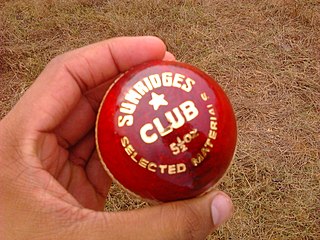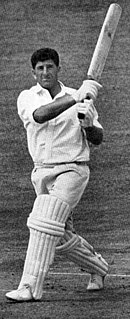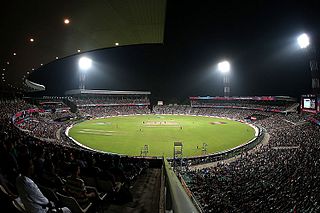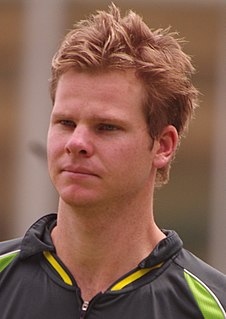Related Research Articles
A spitball is an illegal baseball pitch in which the ball has been altered by the application of a foreign substance such as saliva or petroleum jelly.
In the game of cricket, the cricket pitch consists of the central strip of the cricket field between the wickets. It is 22 yd (20.12 m) long and 10 ft (3.05 m) wide. The surface is flat and is normally covered with extremely short grass, but can be completely dry or dusty soil with barely any grass or, in some circumstances, made from an artificial material. Over the course of a cricket match, the pitch is not repaired or altered other than in special circumstances - meaning that it will change condition. Any grass on the pitch in the game's first over, for example, may have disappeared by the twentieth over due to wear.
In cricket, a no-ball is an illegal delivery to a batsman. It is also the Extra run awarded to the batting team as a consequence. For most cricket games, especially amateur the definition of all forms of no-ball is from the MCC Laws of Cricket

A cricket ball is a hard, solid ball used to play cricket. A cricket ball consists of a cork core wound with string then a leather cover stitched on, and manufacture is regulated by cricket law at first-class level. The trajectory of a cricket ball when bowled, through movement in the air, and off the ground, is influenced by the action of the bowler and the condition of the ball and the pitch, while working on the cricket ball to obtain optimum condition is a key role of the fielding side. The principal method through which the batsman scores runs is by hitting the ball, with the bat, into a position where it would be safe to take a run, or by directing the ball through or over the boundary. Cricket balls are harder and heavier than baseballs.
Swing bowling is a technique used for bowling in the sport of cricket. Practitioners are known as swing bowlers. Swing bowling is generally classed as a subtype of fast bowling.

In cricket, a dismissal occurs when a batsman's period of batting is brought to an end by the opposing team. It is also known as the batsman being out, the batting side losing a wicket, and the fielding side taking a wicket. The dismissed batsman must leave the field of play permanently for the rest of their team's innings, and is replaced by a teammate. A team's innings ends if 10 of the 11 team members are dismissed - as players bat in pairs, when only one person is undismissed it is not possible for the team to bat any longer. This is known as bowling out the batting team, who are said to be all out.
Bishan Singh Bedi
Baseball and cricket are the best-known members of a family of related bat-and-ball games.

Run out is a method of dismissal in the sport of cricket governed by Law 38 of the Laws of cricket.
Law 41 of the Laws of Cricket covers unfair play. This law has developed and expanded over time as various incidents of real life unfair play have been legislated against.

Kenneth Frank Barrington, was an English international cricketer who played for the England cricket team and Surrey County Cricket Club in the 1950s and 1960s. He was a right-handed batsman and occasional leg-spin bowler, known for his jovial good humour and long, defensive innings "batting with bulldog determination and awesome concentration".

Robert George Dylan Willis was an English cricketer, who played for Surrey, Warwickshire, Northern Transvaal and England. A right-handed and aggressive fast bowler with a notably long run-up, Willis spearheaded several England bowling attacks between 1971 and 1984, across 90 Test matches in which he took 325 wickets at 25.20 runs per wicket, at the time second only to Dennis Lillee. He is England's fourth leading wicket taker as of 2019, behind Jimmy Anderson, Ian Botham and Stuart Broad. Willis took 899 first-class wickets overall, although from 1975 onwards he bowled with constant pain, having had surgery on both knees. He nevertheless continued to find success, taking a Test career-best eight wickets for 43 runs in the 1981 Ashes series against Australia, one of the all-time best Test bowling performances. He was a Wisden Cricketer of the Year for 1978.
Ian Meckiff is a former cricketer who represented Australia in 18 Tests between 1957 and 1963. A left-arm fast bowler, he is best known for two matters that were unrelated to his skill as a player: He was the batsman run out by Joe Solomon in 1960, causing the first Tied Test in cricket history; and in December 1963, his career was sensationally ended when he was called for throwing in the First Test against South Africa by Australian umpire Col Egar. During the late 1950s and early 1960s, there had been a media frenzy about the perceived prevalence of illegal bowling actions in world cricket. The controversy and speculation that dogged Meckiff in the years preceding his final match caused sections of the cricket community to believe that he had been made a scapegoat by the Australian cricket authorities to prove their intent to stamp out throwing.
John Kenneth Lever MBE is an English former international cricketer who played Test and One-Day cricket for England. Lever was a left-arm fast-medium bowler who predominantly swung the ball into right-handed batsmen.

In the sport of cricket, ball tampering is an action in which a fielder illegally alters the condition of the ball. The primary motivation of ball tampering is to interfere with the aerodynamics of the ball to aid swing bowling.

The 1970–71 Ashes series consisted of seven cricket Test matches, each of five days with six hours play each day and eight ball overs. It formed part of the MCC tour of Australia in 1970–71 and the matches outside the Tests were played in the name of the Marylebone Cricket Club. Ray Illingworth's England team beat Bill Lawry's Australians 2–0 and regained the Ashes, the only full Test series in Australia in which the home team failed to win a Test. "The Momentous Series of 1970–71" was pivotal in cricket history and "essentially ushered in the modern period of Test cricket". It was the first Test series to have more than five Tests and the first One Day International in cricket history was played in Melbourne; like the first test match in history it was won by Australia.

Cricket is a bat-and-ball game played between two teams of eleven players on a field at the centre of which is a 20-metre (22-yard) pitch with a wicket at each end, each comprising two bails balanced on three stumps. The batting side scores runs by striking the ball bowled at the wicket with the bat, while the bowling and fielding side tries to prevent this and dismiss each batter. Means of dismissal include being bowled, when the ball hits the stumps and dislodges the bails, and by the fielding side catching the ball after it is hit by the bat, but before it hits the ground. When ten batters have been dismissed, the innings ends and the teams swap roles. The game is adjudicated by two umpires, aided by a third umpire and match referee in international matches. They communicate with two off-field scorers who record the match's statistical information.

The 1974–75 Ashes series consisted of six cricket Test matches, each match lasted five days with six hours of play each day and eight ball overs. It formed part of the MCC tour of Australia in 1974–75 and the matches outside the Tests were played in the name of the Marylebone Cricket Club. Ian Chappell's Australians won the series 4–1 and "brutally and unceremoniously wrenched the Ashes" from Mike Denness's England team. It was Australia's first series victory over England for ten years and the experience proved popular as 777,563 spectators came through the gates and paid nearly a million Australian dollars for the privilege. For the first time the first day of the Third Test at Melbourne was held on Boxing Day in an Ashes series, now a cricketing tradition.
The main point of contention in the umpiring of the 1974–75 Ashes series was the intimidatory bowling of the Australian fast bowlers Dennis Lillee and Jeff Thomson. There were a few other issues, though there were the usual cases of batsmen being given out or not out despite the differing opinions of the players and umpire. At the time, umpires had no recourse to slow motion replays and had to make decisions based on what they saw in a split second, with the benefit of the doubt always going to the batsman. As a result it was not uncommon for umpires to make mistakes, which over the course of a long series tended to cancel each other out. The best an umpire could do was to make an honest judgement based on what he saw. Tom Brooks and Robin Bailhache were the umpires in all six Tests, but were junior for so important a series. Brooks having made his debut in the 1970–71 Ashes series and Bailhache in the First Test at Brisbane. Unusually for Australian umpires of the time Brooks had played First Class Cricket – he had been a lively fast-medium bowler – and as a result was more able to connect with the Test players, and was more forgiving of short-pitched deliveries which he saw as a natural part of the game. This helped England in 1970–71 when they had the fast bowlers John Snow and Bob Willis, but proved fatal for their batsmen in 1974–75.

The 2018 Australian ball-tampering scandal, also known as the Sandpapergate scandal, was a cricket scandal surrounding the Australian national cricket team. In March 2018, during the third Test match against South Africa at Newlands in Cape Town, Cameron Bancroft was caught by television cameras trying to rough up one side of the ball with sandpaper to make it swing in flight. Captain Steve Smith and vice-captain David Warner were found to be involved and all three received unprecedented sanctions from Cricket Australia. Although he was found not to have been directly involved, Australia's coach, Darren Lehmann, announced he would step down from his role following the scandal. Smith was replaced by Tim Paine as Test captain, and Aaron Finch as T20I and ODI captain.
References
- Selvey, Mike (December 11, 2008). "The rankling history of our Vaseline Incident". The Guardian .
http://www.cricinfo.com/ci/content/story/447502.html (accessed 15/04/10)